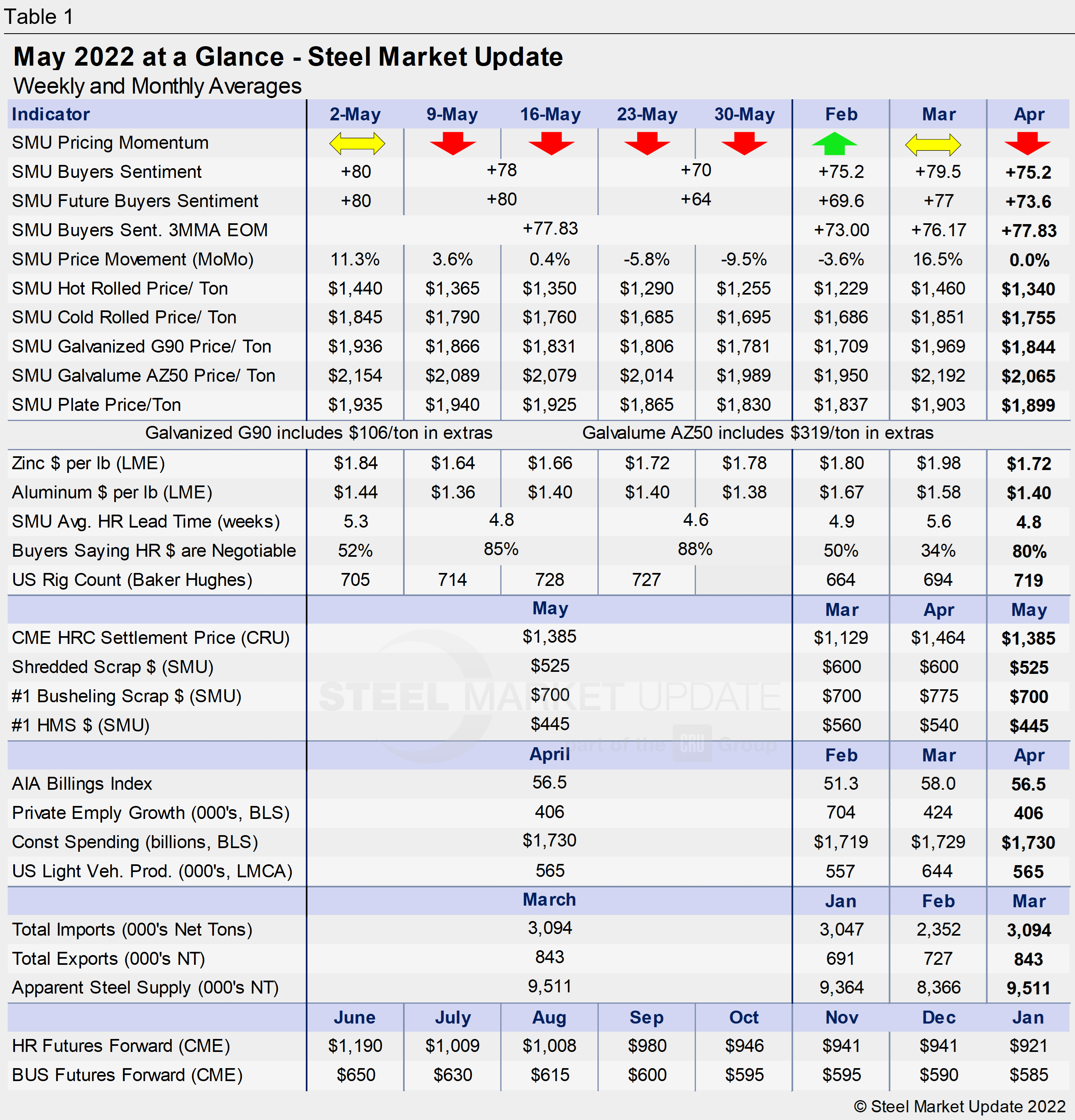Economy

SMU's May at a Glance
Written by Brett Linton
June 1, 2022
Steel prices eased each week in May, following increases in March and most of April. Hot rolled prices were $1,440 per ton ($72 per cwt) the first week of May, just $40 lower than the mid-April peak. Prices then slipped between $15 and $75 each of the following weeks, with the SMU index averaging $1,255 per ton as of last Tuesday. The SMU Price Momentum Indicator was adjusted to Lower for flat rolled products on May 10 and Lower for plate products on May 24, meaning we expect prices to decrease over the next 30 days. Recall that the Momentum Indicator was previously adjusted from Higher to Neutral on April 12.
Raw material prices eased from April’s historical highs: Busheling and shredded scrap prices declined $75 per ton in May, while HMS scrap fell $95 per ton from April. Click here to view and compare prices using our interactive pricing tool. Zinc spot prices eased in the first half of the month, reaching a four-month low of $1.61 per pound on May 13 per Kitco. Zinc prices rose from that point, reaching $1.78 per pound as of May 31. Aluminum prices were overall down in May, moving from $1.48 per pound at the beginning of the month to $1.36 per pound on May 31. On May 9 aluminum prices also reached a four-month low of $1.34 per pound.
The SMU Buyers Sentiment Index remains high, with optimism ranging from +70 to +80 last month. Viewed as a three-month moving average, buyers’ sentiment rose to +78 as of the end of the month, a level not seen since late 2021. Future sentiment readings also remain optimistic, but there were signs of cracks emerging. And the future sentiment index slipped from +80 in early May to +64 as of last week.
Hot rolled lead times peaked in mid-April at 5.8 weeks. They declined throughout May and stood at 4.6 weeks by the end of the month. The percentage of buyers reporting that mills are willing to negotiate on hot-rolled coil prices continues to grow. Data through last week indicates 88% of buyers report that mills are now willing to talk price to secure an order, up from 52% in early May. A history of HRC lead times can been found within our interactive pricing tool.
Key indicators of steel demand remain positive overall. The AIA Billings Index indicated that construction activity remains strong, and the energy and automotive sectors continue to improve. March import and export volumes are up over recent months, with apparent steel supply rebounding to 9.5 million tons in March.
See the chart below for other key metrics in the month of May:

By Brett Linton, Brett@SteelMarketUpdate.com

Brett Linton
Read more from Brett LintonLatest in Economy

Industry groups praise Senate for passing tax and budget bill
The Steel Manufacturers Association and the American Iron and Steel Institute applauded the tax provisions included in the Senate's tax and budget reconciliation bill.

Chicago PMI dips 0.1 points in June
The Chicago Purchasing Managers Index (PMI) slipped 0.1 points to 40.4 points, in June.

Multi-family pullback drives housing starts to 5-year low in May
US housing starts tumbled in May to a five-year low, according to figures recently released by the US Census Bureau.

Architecture firms still struggling, ABI data shows
Architecture firms reported a modest improvement in billings through May, yet business conditions remained soft, according to the latest Architecture Billings Index (ABI) release from the American Institute of Architects (AIA) and Deltek.

Manufacturing in New York state contracts again
However, companies are growing more optimistic about the future.
